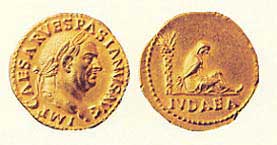Editor, H. S. (2002;2002). BAR 07:02 (March/April 1981). Biblical Archaeology Society.
The Other Side of the Coin
Israel answers ancient Rome's Judea Capta series with Liberata medals
By D. Bernard Hoenig

Israel Museum
A Judea Capta coin, minted in Rome in 71 A.D., is one of a series which celebrates the Roman Emperor Vespasian's victory over Judea. On this gold aureus, Vespasian's profile is encircled by the Latin inscription IMP[erator] CAESAR VESPASIANUS AUG[USTUS]. The reverse side shows defeated Judea, portrayed as a woman, seated next to a palm tree, her hands bound behind her back; below is the inscription IUDAEA.
In the year 70, Jerusalem lay in ruins, the once magnificent Temple reduced to rubble. The Roman conquerors were scattering the people of tiny Judea throughout the empire, beginning another Diaspora–the longest exile in the history of the Jews.
Across the Mediterranean, in the imperial city of Rome, the end of the Jewish Revolt was the occasion for unparalleled jubilation.1 Elaborate parades, forums, carnivals and gladiator contests continued for weeks after the last battle was over. The leading warriors of Judea, including the condemned Shimon Bar Giora and Yochanan Gush-halav, were paraded through the streets of Rome in chains, while holy vessels from the Temple were triumphantly borne by Legionnaires. The procession was immortalized on the Arch of Titus.2
Emperor Vespasian's proudest display, however, was stamped on the thousands of coins he minted to celebrate his conquest of the Jewish nation. 3
The majority of the more than 15 varieties of coins showed Vespasian's profile on one side and the vanquished Judea on the other. Judea is symbolized by a weeping woman sitting or standing under a palm tree guarded by a Roman soldier,4 perhaps Vespasian himself. Most of the strikes exhibit the woman, her hands sometimes bound; a few rare varieties display a male instead.
1Solomon Grayzel, A History of the Jews , (Philadelphia. The Jewish Publication Society of America, 1964), 172-74.
2Alfred H. Tamarin, Revolt in Judea: The Road to Masada , adapted from Josephus' The Jewish War (New York, Galahad Books, 1968), p. 136.
3Heinrich Graetz, History of the Jews , Vol. II. (Philadelphia, The Jewish Publication Society Of America, 1945), p. 314.
4Frederic W. Madden, History of Jewish Coinage , reprint of the 1864 volume (New York, The Library of Biblical Studies, edited by Harry M. Orlinsky, Ktav Publishing House, 1964), pp. 183197.
next page >
page 1:3
 
|
Biblical Archaeology Review
This article is part of the Biblical Archaeology Review Archive CD-ROM. Click here to learn more.
|
|